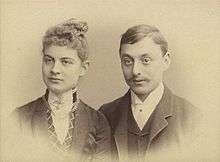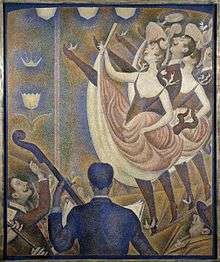Helene Kröller-Müller
| Helene Kröller-Müller | |
|---|---|
 Helene Müller and Anton Kröller, ca. 1888 | |
| Born |
11 February 1869 Essen, Germany |
| Died |
14 December 1939 (aged 70) Otterlo, The Netherlands |
| Nationality | German |
| Occupation | Art collector and philanthropist |
Helene Kröller-Müller (11 February 1869 – 14 December 1939) was one of the first European women to put together a major art collection and credited as being one of the first collectors to recognise the genius of Vincent van Gogh. She donated her entire collection to the Dutch people, along with her and her husband, Anton Müller's, large forested country estate. Today it is the Kröller-Müller Museum and sculpture garden and Hoge Veluwe National Park, the largest national park in the Netherlands.
She was born Helene Emma Laura Juliane Müller at Essen-Horst, Essen, Germany, into a wealthy industrialist family. Her father, Wilhelm Müller, owned Wm. H. Müller & Co., a prosperous supplier of raw materials to the mining and steel industries.[1] She married Dutch shipping and mining tycoon Anton Kröller in 1888 and used both surnames in accordance with Dutch tradition.
She studied under Henk Bremmer in 1906-1907. As she was one of the wealthiest women in the Netherlands at the time, Bremmer recommended that she form an art collection. In 1907, she began her collection with the painting Train in a Landscape by Paul Gabriël. Subsequently, Helene Kröller-Müller became an avid art collector, and one of the first people to recognise the genius of Vincent van Gogh. She eventually amassed more than 90 van Gogh paintings and 185 drawings, one of the world's largest collections of the artist's work, second only to the Van Gogh Museum in Amsterdam. She also bought more than 400 works by Dutch artist Bart van der Leck, but his popularity did not take off like van Gogh's.[2]

Kröller-Müller also collected works by modern artists, such as Picasso, Georges Braque, Jean Metzinger, Albert Gleizes, Fernand Léger, Diego Rivera, Juan Gris, Piet Mondrian, Gino Severini, Joseph Csaky, Auguste Herbin, Georges Valmier, María Blanchard, Léopold Survage and Tobeen. However, Bremmer advised her not to buy A Sunday Afternoon on the Island of La Grande Jatte by Georges Seurat, which turned out to be an important icon of 20th-century art. She did purchase however Le Chahut by Seurat, another icon in the history of modern art.[3] Also, she steered away from artists of her native Germany, whose work she found "insufficiently authoritative."[4]
On a trip to Florence in June 1910, she conceived the idea of creating a museum-house.[5] From 1913 onwards parts of her collection were open to the public; until the mid-1930s her exhibition hall in The Hague was one of the very rare places where one could see more than a few works of modern art.[6] In 1928, Anton and Helene created the Kröller-Müller Foundation to protect the collection and the estates. In 1935, they donated to the Dutch people their entire collection totaling approximately 12,000 objects, on condition that a large museum be built in the gardens of her park.[7] Held in the care of the Dutch government, the Kröller-Müller Museum was opened in 1938.
The Kröller-Müller Museum is nestled in their 75-acre (300,000 m2) forested country estate, today the largest national park in the Netherlands, the Hoge Veluwe National Park near the town of Otterlo and Arnhem. A lavish art gallery was planned near their iconic lakeside Jachthuis Sint Hubertus hunting lodge and landscape statue of their close personal friend, the South African Boer General Christian de Wet on the estate.[8] Due to threat of war the plans were never implemented in their lifetime but once the war was a large forest sculpture garden and understated open exhibition extension was opened, housing statues by Rodin and the second largest collection of van Gogh paintings in the world, including the famous Sunflowers.
See also
Further reading
- Kröller-Müller State Museum, Otterlo. Netherlands: Kröller-Müller State Museum, 1973.
- Rovers, Eva. De eeuwigheid verzameld: Helene Kröller-Müller 1869-1939. Prometheus Bv Vassallucci, Uitgeverij 2010. ISBN 978-9035135512
References
- ↑ Joshua Levine (21 May 2009), The Vision Quest of Helene Kroller-Muller Forbes magazine.
- ↑ Sheila Farr (May 23, 2004) How a museum founder helped turn van Gogh into an international icon The Seattle Times.
- ↑ Catalogus van de schilderijen verzameling van Mevrouw H. Kröller-Müller, Samensteller H.P. Bremmer, Published 1921 in 'S-Gravenhage (in Dutch)
- ↑ Sheila Farr (May 23, 2004) How a museum founder helped turn van Gogh into an international icon The Seattle Times.
- ↑ Joshua Levine (May 21, 2009), The Vision Quest of Helene Kroller-Muller Forbes magazine.
- ↑ Helene Kröller-Müller and the breakthrough of modern art University of Groningen - Institute of Biography.
- ↑ Alan Riding (12 March 2003), Glimpses Into van Gogh's Imagination; Two Dutch Museums Offer Fresh Angles on a Favorite Son New York Times.
- ↑ "Art, architecture, and nature — Park Hoge Veluwe". www.hogeveluwe.nl. Retrieved 2015-08-25.